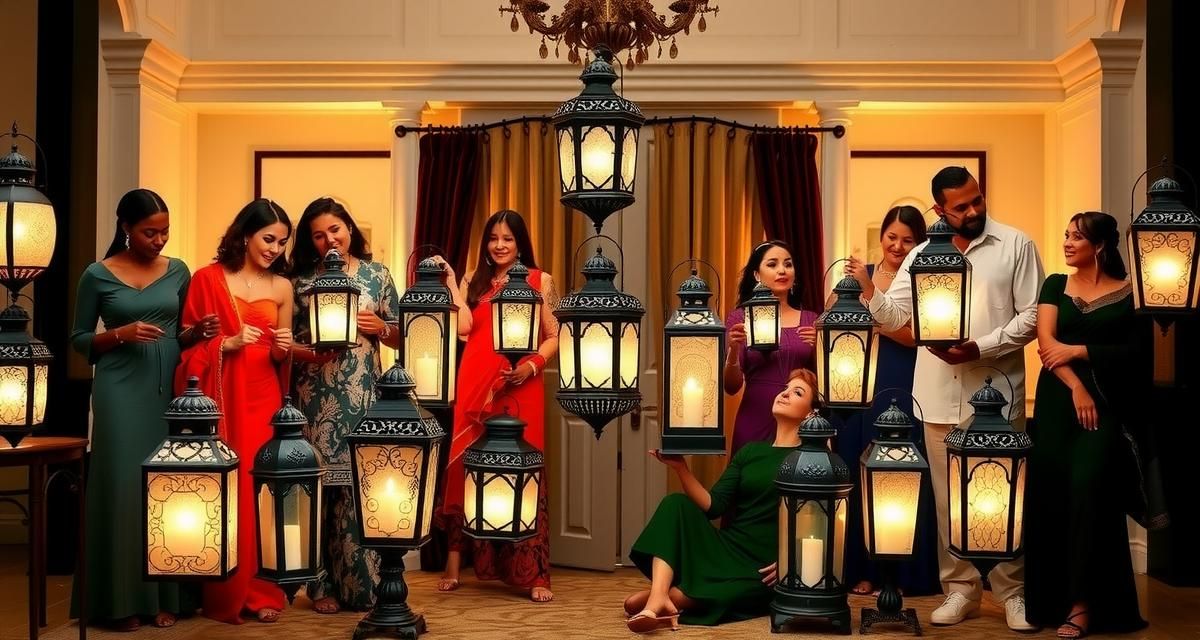Lanterns have been a source of light and decoration for centuries, evolving from simple oil lamps to sophisticated solar-powered devices. This guide explores the diverse world of lanterns, offering insights into their types, mechanisms, and uses, both indoors and outdoors.
What are the different types of lanterns?
Traditional oil and candle lanterns
Traditional oil and candle lanterns have been used for centuries, providing a warm, flickering light that creates a cozy atmosphere. These lanterns are often made from metal or glass and are popular for their classic aesthetic. They are ideal for creating a vintage or rustic ambiance in any setting.
- Materials : Typically made from metal, glass, or ceramic.
- Uses : Perfect for indoor decor and outdoor gatherings.
- Maintenance : Requires regular cleaning and refilling of oil or replacement of candles.
Modern electric and solar-powered lanterns
Modern electric lanterns offer convenience and efficiency, often featuring LED lights that provide bright illumination with minimal energy consumption. Solar-powered lanterns are an eco-friendly option, harnessing sunlight to charge during the day and providing light at night.
- Energy Source : Electric lanterns use batteries or plug-in power, while solar lanterns use sunlight.
- Advantages : Long-lasting, energy-efficient, and environmentally friendly.
- Applications : Suitable for both indoor and outdoor use, especially in areas with ample sunlight.
Decorative and festival lanterns
Decorative and festival lanterns are designed to enhance the aesthetic appeal of a space or event. They come in various shapes, sizes, and colors, often used in cultural celebrations and festivals around the world.
- Designs : Available in a wide range of styles, from simple paper lanterns to intricate metal designs.
- Occasions : Commonly used in festivals like Diwali, Chinese New Year, and Halloween.
- Impact : Adds a festive and vibrant touch to any celebration.
How do lanterns work?
Fuel-based lantern mechanisms
Fuel-based lanterns operate by burning a fuel source, such as oil or kerosene, to produce light. These lanterns are equipped with a wick that absorbs the fuel, which is then ignited to create a flame.
- Components : Wick, fuel reservoir, and chimney.
- Operation : Requires regular refueling and wick trimming.
- Considerations : Ensure proper ventilation to prevent the buildup of harmful fumes.
Battery-operated lantern technology
Battery-operated lanterns use batteries to power LED or incandescent bulbs, providing a reliable and portable light source. These lanterns are popular for their ease of use and versatility.
- Power Source : Typically powered by AA, AAA, or rechargeable batteries.
- Features : Often include adjustable brightness settings and long battery life.
- Suitability : Ideal for camping, emergencies, and power outages.
Solar-powered lantern systems
Solar-powered lanterns utilize photovoltaic cells to convert sunlight into electricity, which is stored in rechargeable batteries. These lanterns are an excellent choice for sustainable lighting solutions.
- Charging : Requires exposure to sunlight for optimal charging.
- Benefits : Reduces reliance on non-renewable energy sources and lowers electricity costs.
- Limitations : Performance may vary based on weather conditions and sunlight availability.
What are the best lanterns for outdoor activities?
Camping and hiking lanterns
Camping and hiking lanterns are designed to be lightweight, durable, and easy to carry. They provide essential lighting for outdoor adventures, ensuring safety and visibility in the dark.
- Features : Compact design, water resistance, and adjustable brightness.
- Brands : Popular options include Coleman and Black Diamond.
- Usage : Perfect for camping trips, hiking trails, and backpacking expeditions.
Emergency and survival lanterns
Emergency and survival lanterns are crucial for preparedness during power outages and natural disasters. These lanterns are built to withstand harsh conditions and provide reliable lighting when needed most.
- Characteristics : Long battery life, rugged construction, and multiple lighting modes.
- Functionality : Some models include additional features like USB charging ports and SOS signals.
- Recommendation : Keep a few in your emergency kit for unexpected situations.
Patio and garden lanterns
Patio and garden lanterns enhance outdoor spaces by providing ambient lighting and decorative appeal. They are available in various styles, from string lights to standalone lanterns.
- Design Options : Solar-powered, electric, or candle-lit.
- Placement : Ideal for patios, gardens, and outdoor dining areas.
- Effect : Creates a warm and inviting atmosphere for outdoor gatherings.
How to choose the right lantern for your needs?
Brightness and lumens
When selecting a lantern, consider the brightness level, measured in lumens. Higher lumens indicate brighter light, which is essential for activities requiring clear visibility.
- Range : Lanterns typically range from 100 to 1000 lumens.
- Purpose : Choose higher lumens for outdoor activities and lower lumens for ambient indoor lighting.
- Balance : Consider the trade-off between brightness and battery life.
Battery life and power sources
Battery life is a critical factor, especially for long trips or emergencies. Evaluate the power source options, such as disposable batteries, rechargeable batteries, or solar power.
- Duration : Look for lanterns with extended battery life for prolonged use.
- Rechargeability : Opt for rechargeable models to reduce waste and save on battery costs.
- Compatibility : Ensure the lantern is compatible with readily available battery types.
Durability and weather resistance
Durability and weather resistance are essential for outdoor lanterns exposed to the elements. Look for lanterns made from robust materials with water and impact resistance.
- Materials : Consider lanterns made from high-quality plastic, metal, or rubber.
- Protection : Check for IP ratings indicating water and dust resistance.
- Longevity : Durable lanterns withstand rough handling and harsh weather conditions.
What are the most popular lantern brands?
Coleman lanterns
Coleman is a well-known brand in the outdoor industry, offering a wide range of lanterns known for their reliability and performance. Their products are favored by campers and outdoor enthusiasts.
- Reputation : Trusted for quality and innovation.
- Variety : Offers both fuel-based and battery-operated models.
- Customer Feedback : Highly rated for durability and brightness.
Black Diamond lanterns
Black Diamond specializes in outdoor gear, including lanterns designed for adventure and exploration. Their lanterns are compact, efficient, and feature advanced lighting technology.
- Innovation : Known for incorporating cutting-edge technology.
- Design : Focuses on lightweight and portable solutions.
- User Experience : Praised for ease of use and functionality.
Elan Bazaar lanterns
Elan Bazaar offers a unique selection of decorative lanterns that blend traditional craftsmanship with modern design. Their lanterns are perfect for enhancing home decor and creating a cozy ambiance.
- Aesthetic Appeal : Combines elegance with functionality.
- Customization : Offers a variety of styles and finishes.
- Market Presence : Gaining popularity for their artistic designs.
How to maintain and care for your lanterns?
Cleaning and storage tips
Proper maintenance ensures the longevity and performance of your lanterns. Regular cleaning and appropriate storage are essential to keep them in good condition.
- Cleaning : Use a soft cloth and mild detergent to clean the exterior.
- Storage : Store in a cool, dry place away from direct sunlight.
- Inspection : Regularly check for damage or wear and tear.
Replacing parts and refueling
For fuel-based lanterns, replacing parts and refueling are necessary to maintain functionality. Ensure you have the right supplies and follow the manufacturer’s instructions.
- Parts : Keep spare wicks, mantles, and fuel on hand.
- Refueling : Use the recommended fuel type and avoid overfilling.
- Safety : Follow safety guidelines to prevent accidents.
Troubleshooting common issues
Understanding common issues and their solutions can help you troubleshoot problems with your lanterns. This knowledge ensures your lanterns remain operational when needed.
- Flickering Light : Check battery connections or fuel levels.
- Dim Light : Replace batteries or clean the lens.
- Non-Functioning : Inspect for damaged components or faulty wiring.
What are the safety considerations when using lanterns?
Fire hazards and prevention
Lanterns, especially those using open flames, pose fire hazards. It’s crucial to follow safety precautions to prevent accidents and ensure safe usage.
- Placement : Keep lanterns away from flammable materials.
- Supervision : Never leave a lit lantern unattended.
- Extinguishing : Ensure flames are fully extinguished after use.
Proper ventilation for fuel-based lanterns
Fuel-based lanterns produce fumes that can be harmful if inhaled. Proper ventilation is necessary to ensure safety and prevent health risks.
- Location : Use in well-ventilated areas to disperse fumes.
- Monitoring : Be aware of signs of poor ventilation, such as dizziness or headaches.
- Alternatives : Consider electric or solar lanterns for indoor use.
Child and pet safety measures
Lanterns can be hazardous to children and pets if not used responsibly. Implement safety measures to protect them from potential harm.
- Accessibility : Keep lanterns out of reach of children and pets.
- Education : Teach children about lantern safety and proper handling.
- Supervision : Monitor pets around lanterns to prevent accidents.
How are lanterns used in different cultures and traditions?
Chinese lantern festivals
Chinese lantern festivals are celebrated with vibrant lantern displays, symbolizing prosperity and good fortune. These festivals are a significant cultural event in China and other Asian countries.
- Significance : Marks the end of the Chinese New Year celebrations.
- Activities : Includes lantern parades, riddles, and cultural performances.
- Symbolism : Represents unity, peace, and hope.
Diwali and the festival of lights
Diwali, known as the festival of lights, is celebrated with the lighting of lamps and lanterns to signify the triumph of light over darkness. It is a major Hindu festival observed worldwide.
- Traditions : Involves decorating homes with lanterns and oil lamps.
- Meaning : Celebrates the victory of good over evil.
- Festivities : Includes fireworks, feasting, and family gatherings.
Halloween jack-o’-lanterns
Halloween is synonymous with jack-o’-lanterns, carved pumpkins illuminated from within. This tradition has its roots in Irish folklore and is a popular Halloween decoration.
- Origin : Based on the legend of Stingy Jack and the use of turnips.
- Crafting : Involves carving faces or designs into pumpkins.
- Celebration : Adds a spooky and festive touch to Halloween festivities.
What are the environmental impacts of lanterns?
Eco-friendly lantern options
Eco-friendly lanterns are designed to minimize environmental impact by using sustainable materials and energy sources. These lanterns are a responsible choice for environmentally conscious consumers.
- Materials : Made from recycled or biodegradable materials.
- Energy : Utilizes renewable energy sources like solar power.
- Benefits : Reduces carbon footprint and conserves natural resources.
Recycling and disposing of lanterns
Proper recycling and disposal of lanterns are essential to prevent environmental harm. Follow guidelines to ensure responsible handling of lantern waste.
- Recycling : Check local recycling programs for lantern components.
- Disposal : Dispose of batteries and fuel responsibly.
- Awareness : Educate others about the importance of recycling lanterns.
Reducing light pollution
Lanterns contribute to light pollution, which affects wildlife and disrupts natural ecosystems. Responsible use of lanterns can help mitigate this issue.
- Impact : Excessive light disrupts nocturnal wildlife and human sleep patterns.
- Solutions : Use lanterns with adjustable brightness and timers.
- Conservation : Support initiatives aimed at reducing light pollution.
How can lanterns enhance home decor and ambiance?
Indoor lantern placement ideas
Lanterns can transform indoor spaces by adding warmth and character. Consider various placement ideas to enhance your home decor.
- Entryways : Place lanterns at the entrance for a welcoming touch.
- Living Rooms : Use lanterns as centerpieces or accent lighting.
- Bedrooms : Create a cozy atmosphere with soft, ambient lighting.
Outdoor lantern landscaping tips
Outdoor lanterns can elevate the aesthetic appeal of gardens and patios. Use them strategically to highlight features and create a magical ambiance.
- Pathways : Line walkways with lanterns for safe navigation.
- Focal Points : Illuminate garden features like fountains or sculptures.
- Seating Areas : Enhance outdoor seating with soft, inviting light.
DIY lantern crafts and projects
DIY lantern projects offer a creative way to personalize your decor. Crafting your own lanterns can be a fun and rewarding experience.
- Materials : Use recycled materials like jars, cans, or paper.
- Designs : Experiment with different shapes, colors, and patterns.
- Activities : Enjoy crafting with family and friends for a personal touch.
What are the latest innovations in lantern technology?
Smart lanterns with app control
Smart lanterns integrate technology for enhanced functionality, allowing users to control lighting through smartphone apps. These lanterns offer convenience and customization.
- Features : Includes remote control, scheduling, and color adjustment.
- Compatibility : Works with smart home systems like Alexa or Google Home.
- Advantage : Provides personalized lighting experiences.
Multi-functional lanterns with added features
Multi-functional lanterns combine lighting with additional features, such as speakers, power banks, or insect repellents. These versatile lanterns are ideal for various situations.
- Integration : Combines multiple functions in one device.
- Utility : Useful for camping, emergencies, and outdoor events.
- Innovation : Continually evolving to meet diverse needs.
Ultra-lightweight and compact designs
Advancements in materials and design have led to ultra-lightweight and compact lanterns, perfect for travelers and outdoor enthusiasts.
- Portability : Easy to carry and pack for trips.
- Efficiency : Maintains brightness and functionality despite reduced size.
- Trend : Increasing demand for lightweight gear in outdoor activities.
FAQ
What is the history of lanterns?
The history of lanterns dates back to ancient times, evolving from simple oil lamps to modern electric devices. Lanterns have been used for illumination, decoration, and cultural rituals throughout history. They hold significant cultural and historical value in various societies.
How long do battery-powered lanterns typically last?
Battery-powered lanterns typically last between 10 to 100 hours, depending on the brightness setting and battery type. Factors such as battery quality and usage patterns can affect longevity. To extend battery life, use energy-efficient settings and rechargeable batteries.
Are lanterns allowed in national parks?
Lanterns are generally allowed in national parks, but regulations vary by location. It’s important to check specific park rules regarding open flames and fuel-based lanterns. Consider using electric or solar lanterns as alternatives to minimize environmental impact.
What are the best lanterns for power outages?
The best lanterns for power outages are those with long-lasting battery life and reliable performance. Look for models with multiple lighting modes and emergency features. Dual-purpose lanterns with charging capabilities are also beneficial for powering devices during outages.
How do you hang lanterns safely?
To hang lanterns safely, use proper hanging techniques and support structures. Ensure the surface can support the lantern’s weight and use appropriate hooks or brackets. Consider the height and placement to prevent accidents and ensure stability.







